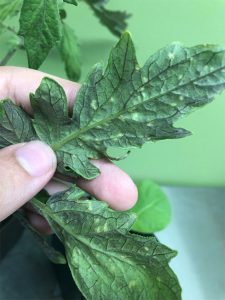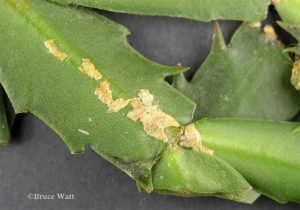Edema
Pest Management Fact Sheet #5060
Developed byDeveloped by Alicyn Smart, Assistant Extension Professor & Extension Plant Pathologist, and Nathan Andrews
For information about UMaine Extension programs and resources, visit extension.umaine.edu.
Find more of our publications and books at extension.umaine.edu/publications/.
Other Name: Oedema
Pathogen: Abiotic Disease
Introduction
Edema is a physiological disease that effects leaves, stems, and fruit of plants. This disease occurs when the plant takes up an excess amount of water, causing cells to rupture. Edema occurs when the soil moisture is wet and can be worsened by cold, wet weather and low air circulation. During droughts followed by heavy rain, edema has been observed due to the fast uptake of water by plants.
Host Plants
- All vegetables and herbaceous plants
Symptoms and Signs
Blisters will form on the underside of leaves that can vary in color from light green to yellow and beige (Fig. 1). As these blisters age, they will eventually have the color and texture of cork (Fig. 2). These blisters can also be seen from the top of the leaf as well. As the condition worsens, this can lead to leaves falling off and to plants appearing spindly or “leggy.” Edema blisters can also appear on the stems and fruit of plants, leaving similar corky blisters in these parts of the plant.
- Figure 1. Early stage edema blisters on the underside of a tomato leaf. Photo by Nathan Andrews.
- Figure 2. Mature blisters with corky color and texture formed on a Schlumbergera plant. Photo by Dr. Bruce Watt.
Management
Prevent edema by allowing the top two inches of the soil to dry between watering and space plants out appropriately for maximum air flow. Avoid overwatering plants, especially during the winter and early spring. Affected plants will gradually recover when growing conditions improve.
References
Chaverri, Priscila. Edema – Vegetables. Retrieved from University of Maryland – Cooperative Extension: https://extension.umd.edu/hgic/topics/edema-vegetables
Madeiras, Angela (2019). Edema and Intumescence. Retrieved from University of Massachusetts, Amherst – Extension: https://ag.umass.edu/greenhouse-floriculture/fact-sheets/edema-intumescence
WHEN USING PESTICIDES, ALWAYS FOLLOW LABEL DIRECTIONS!
Alicyn Smart, DPM
Plant Pathologist and Director of the Plant Disease Diagnostic Laboratory
University of Maine Cooperative Extension
Information in this publication is provided purely for educational purposes. No responsibility is assumed for any problems associated with the use of products or services mentioned. No endorsement of products or companies is intended, nor is criticism of unnamed products or companies implied.
© 2019
Call 800.287.0274 (in Maine), or 207.581.3188, for information on publications and program offerings from University of Maine Cooperative Extension, or visit extension.umaine.edu.
The University of Maine is an EEO/AA employer, and does not discriminate on the grounds of race, color, religion, sex, sexual orientation, transgender status, gender expression, national origin, citizenship status, age, disability, genetic information or veteran’s status in employment, education, and all other programs and activities. The following person has been designated to handle inquiries regarding non-discrimination policies: Sarah E. Harebo, Director of Equal Opportunity, 101 North Stevens Hall, University of Maine, Orono, ME 04469-5754, 207.581.1226, TTY 711 (Maine Relay System).



